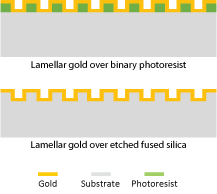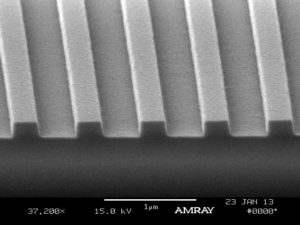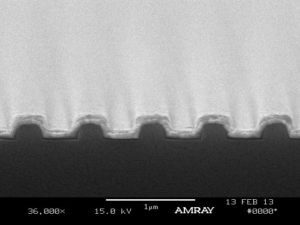The superior performance of PGL gold gratings comes from our proprietary gold coating process that produces a conformal coating which results in higher diffraction efficiency. We have placed an emphasis on this process because we have recognized that gold-over-glass coating is crucial to good grating performance. The coatings are also highly uniform over very large substrate areas.
The high efficiency of these gratings, combined with their wide reflection bandwidth, exceptionally low overall diffracted wavefront error, and good laser damage threshold, make them an excellent choice for today’s most demanding short-pulse compression systems.

The process PGL has developed for gold coating provides a conformal lamellar coating over precise features. Gold over etched fused silica provides better performance characteristics and uniformity than gold over photoresist gratings. Scatter from gold-over-glass gratings is lower and they have been shown to exhibit better temporal contrast in pulse stretchers than resist-based gratings [1].

These gratings are also far less delicate than standard metal-coated photoresist gratings. For example, they will not dissolve in acetone.
Some studies have shown that femtosecond laser damage threshold is higher in etched silica gratings than in photoresist gratings. Furthermore, PGL has found that laser damage typically does not extend into the underlying silica [2].
The gold can be stripped from etched fused silica with little to no damage to the grating. This property aids fabrication and also enables remanufacturing. If the gold becomes damaged during use (via contamination or laser damage), the grating may be shipped to PGL for stripping and recoating so long as the damage has not extended into the silica structure.
It is clear that even for highly conformal coatings the grating depth and duty cycle are impacted and therefore must be controlled very carefully. Figures 1 and 2 show SEM images of an etched fused silica grating before (1) and after (2) it is coated with gold.


[1] Hooker, et al, Optics Express v19, n3, 2011
[2] Poole, et al, Optics Express v21, n22, 2013
5 Commerce Way, Carver, MA 02330, USA|+1.508.503.1719|sales@plymouthgrating.com